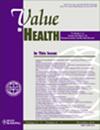基于价值的适应性设计教程:基于价值的连续双臂设计能否为大型 CACTUS 试验创造更多的健康经济价值?
IF 4.9
2区 医学
Q1 ECONOMICS
引用次数: 0
摘要
目标:基于价值的试验旨在通过平衡技术采用决策和临床试验成本,最大限度地提高预期净效益。适应性试验可提高效率。本文通过一个案例研究,为确定基于价值的序列设计是否是适应性双臂试验的最佳选择提供指导:方法:我们概述了基于价值的序列方法的四个步骤。案例研究利用试点试验数据和基于模型的卫生经济分析重新评估了 Big CACTUS 试验设计。计算了(a)原始固定设计、(b)基于价值的固定样本量设计和(c)基于价值的最优顺序设计以及自适应停止的预期净效益。我们将试验前的模型与 Big CACTUS 的实际试验结果进行了比较:结果:十年间,采用该疗法的决定将影响约 215,378 名患者。试验前建模显示:(a) 原始固定设计的预期净收益减去成本为 1.02 亿英镑;(b) 最佳固定样本量的基于价值的设计为 1.07 亿英镑(高出 5.3%);(c) 每臂最大样本量为 435 个的最佳基于价值的序列设计为 1.09 亿英镑(高出 6.7%)。使用 Big CACTUS 实际试验数据进行的事后分析表明,最大样本量为 95 对参与者的价值自适应试验不会提前停止。Bootstrap 模拟显示,n=95 时提前结束试验的概率为 9.76%,而 n=435 时为 31.50%:基于价值的顺序双臂设计的四步骤自适应停止方法已成功实施。进一步应用基于价值的自适应方法可能有助于评估替代研究设计的效率。本文章由计算机程序翻译,如有差异,请以英文原文为准。
A Tutorial on Value-Based Adaptive Designs: Could a Value-Based Sequential 2-Arm Design Have Created More Health Economic Value for the Big CACTUS Trial?
Objectives
Value-based trials aim to maximize the expected net benefit by balancing technology adoption decisions and clinical trial costs. Adaptive trials offer additional efficiency. This article provides guidance on determining whether a value-based sequential design is the best option for an adaptive 2-arm trial, illustrated through a case study.
Methods
We outlined 4 steps for the value-based sequential approach. The case study re-evaluates the Big CACTUS trial design using pilot trial data and a model-based health economic analysis. Expected net benefit is computed for (1) original fixed design, (2) value-based design with fixed sample size, and (3) optimal value-based sequential design with adaptive stopping. We compare pretrial modeling with the actual Big CACTUS trial results.
Results
Over 10 years, the adoption decision would affect approximately 215 378 patients. Pretrial modeling shows that the expected net benefit minus costs are (1) £102 million for the original fixed design, (2) £107 million (+5.3% higher) for the value-based design with optimal fixed sample size, and (3) £109 million (+6.7% higher) for the optimal value-based sequential design with maximum sample size of 435 per arm. Post hoc analysis using actual Big CACTUS trial data indicates that the value-adaptive trial with a maximum sample size of 95 participant pairs would not have stopped early. Bootstrap simulations reveal a 9.76% probability of early completion with n = 95 pairs compared with 31.50% with n = 435 pairs.
Conclusions
The 4-step approach to value-based sequential 2-arm design with adaptive stopping was successfully implemented. Further application of value-based adaptive approaches could be useful to assess the efficiency of alternative study designs.
求助全文
通过发布文献求助,成功后即可免费获取论文全文。
去求助
来源期刊

Value in Health
医学-卫生保健
CiteScore
6.90
自引率
6.70%
发文量
3064
审稿时长
3-8 weeks
期刊介绍:
Value in Health contains original research articles for pharmacoeconomics, health economics, and outcomes research (clinical, economic, and patient-reported outcomes/preference-based research), as well as conceptual and health policy articles that provide valuable information for health care decision-makers as well as the research community. As the official journal of ISPOR, Value in Health provides a forum for researchers, as well as health care decision-makers to translate outcomes research into health care decisions.
 求助内容:
求助内容: 应助结果提醒方式:
应助结果提醒方式:


